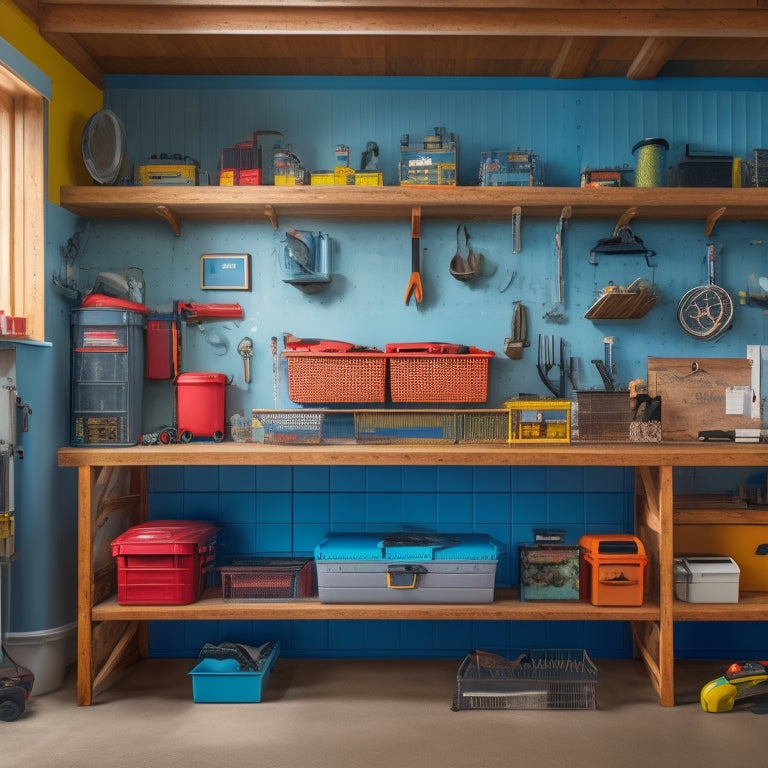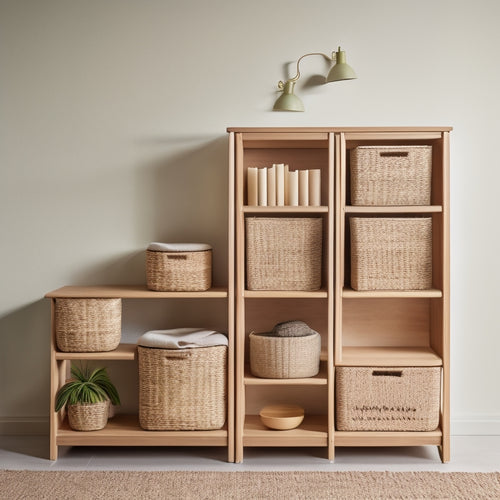
10 Essential Tips for HVAC Tool Storage Success
Share
You're wasting time and money due to ineffective tool storage, leading to damaged equipment, delayed projects, and frustrated team members. To change this, start by evaluating your tool storage needs, measuring your vehicle's storage space, and choosing the right tool organizers. Clearly label and sign your tools, store heavy ones at the bottom, and protect them from weather and moisture. Consider portable storage and implement a tool maintenance schedule. Finally, optimize your storage for efficiency by categorizing tools, using pegboards, and storing tools by frequency of use. By following these essential tips, you'll uncover even more ways to streamline your workflow.
Key Takeaways
• Determine tool storage needs by categorizing tools by type, frequency of use, and priority, and considering weight, size, and fragility.
• Optimize storage space by measuring the vehicle's storage area, mapping out the layout, and utilizing accurate measurements to maximize space utilization.
• Choose the right tool organizers that fit the HVAC toolkit's unique needs, including divided compartments, lockable toolboxes, and customizable inserts.
• Label and sign tools using color coding, barcode scanning, and descriptive labels to increase productivity and reduce confusion.
• Store heavy tools safely at the bottom of shelves or storage units, ensuring even weight distribution and using sturdy shelves to prevent damage or injury.
Assess Your Tool Storage Needs
Assess Your Tool Storage Needs
Determine the types and quantities of tools you need to store by taking stock of your current HVAC toolkit and identifying any gaps or redundancies. This is your Tool Inventory, and it's crucial to get it right.
Make a list of all your tools, including hand tools, power tools, and equipment. Check if you have duplicates or outdated tools that can be retired or replaced. A thorough Storage Audit will help you pinpoint what you need to store, what you can get rid of, and what you need to purchase.
Next, categorize your tools by type, frequency of use, and priority. This will give you a clear picture of what you need to store and how to organize it efficiently. Consider the weight, size, and fragility of each tool to ensure they're stored safely and securely.
Measure Your Vehicle's Storage Space
You'll need to take accurate measurements of your vehicle's interior to guarantee a perfect fit for your HVAC tools and equipment. Start by recording the interior dimensions, including the length, width, and height of the cargo area.
Next, map out the storage compartment layout, noting any obstructions, shelves, or compartments that may impact your storage design.
Vehicle Interior Dimensions
Measure your vehicle's interior dimensions to determine the maximum storage space available for your HVAC tools and equipment. You'll want to take precise measurements of the cargo space, paying attention to any obstructions like seat belts or consoles. Consider the seat configuration, too - can you fold down seats to create more space, or are they fixed in place?
Take note of the width, length, and height of the cargo area, as well as any compartments or shelves. Don't forget to measure the doors and windows, ensuring you can easily load and unload your gear.
You might be surprised at how much space you can utilize with the right measurements.
Storage Compartment Layout
Your vehicle's storage space is now a blank canvas, ready to be optimized with a strategic storage compartment layout that maximizes every inch of available space. To get started, take precise measurements of your vehicle's interior dimensions, noting any obstructions or irregularities. This will help you determine the ideal layout for your storage compartments.
Here are some essential considerations for your storage compartment layout:
-
Cable management: Plan for dedicated spaces to store cables, wires, and hoses, keeping them organized and untangled.
-
Shelf dividers: Incorporate dividers to separate tools and equipment, preventing clutter and making it easier to find what you need.
-
Prioritize frequently used items: Place your most-used tools and equipment in easy-to-access locations, saving time and effort.
- Leave space for growth: Don't overcrowd your storage compartments – leave some room for future additions or changes to your toolkit.
Choose the Right Tool Organizers
Now that you've measured your vehicle's storage space, it's time to choose the right tool organizers to maximize that space.
You'll need to contemplate the essentials you want to include in your tool box, such as compartments for frequently used items and smaller storage bins for loose parts.
You'll also want to think about portable storage options, like pouches and bags, to keep your tools within easy reach.
Tool Box Essentials
Optimize your tool box's storage capacity by selecting the right organizers that fit your HVAC toolkit's unique needs and layout. This is where you'll store your most frequently used tools, so getting it right is crucial. You want to make sure that your tools are easily accessible, protected from damage, and secure from theft.
When it comes to tool box essentials, consider the following:
-
Divided compartments: Separate your tools into categories, such as hand tools, power tools, and testing equipment, to prevent clutter and make it easier to find what you need.
-
Toolbox security: Invest in a lockable toolbox or add a padlock to prevent unauthorized access to your valuable tools.
-
Customizable inserts: Choose inserts that can be tailored to fit your specific toolset, ensuring a snug and secure fit.
- Weather-resistant materials: Opt for toolbox organizers made from durable, weather-resistant materials that can withstand the rigors of your job site.
Portable Storage Options
Choosing the appropriate portable storage options for your HVAC toolkit can greatly enhance your productivity and efficiency on the job site. You'll want to contemplate tool organizers that provide easy access to your tools while keeping them protected from the elements. Look for portable storage solutions with durable construction, such as waterproof cases or rugged tool chests.
When selecting a portable storage option, think about tool mobility. You'll want to opt for an organizer that allows you to easily transport your tools to offsite locations. Reflect on a tool bag or backpack with multiple compartments to keep your tools organized and within reach. This will save you time and energy when moving from one job site to another.
Additionally, consider portable storage options that offer offsite access to your tools. A portable tool chest or storage container with a lock can keep your tools secure when you're not on the job site.
Label and Sign Your Tools Clearly
By assigning a unique identity to each tool through clear labeling and signage, you guarantee that everyone in your HVAC team can quickly identify the right equipment for the job. This saves time, reduces confusion, and increases productivity.
To take your labeling and signage to the next level, consider these tips:
-
Use color coding to categorize tools by type, function, or frequency of use. This visual system helps you quickly locate the tool you need.
-
Implement barcode scanning to track tool inventory, monitor usage, and schedule maintenance. This digital system streamlines your operations and provides valuable insights.
-
Add descriptive labels that include the tool's name, description, and any relevant instructions. This ensures that everyone understands how to use the tool correctly.
- Use clear and concise signage to direct team members to specific tool categories or storage locations. This helps maintain a sense of organization and order in your storage space.
Store Heavy Tools at the Bottom
Now that your tools are clearly labeled and signed, it's time to focus on strategic storage placement, starting with the heaviest tools. You should store heavy tools at the bottom of shelves or storage units to prevent them from falling and causing damage or injury. This is important for tool safety, as heavy tools can be hazardous if they're not stored properly. By keeping them at the bottom, you'll minimize the risk of accidents and maintain a safer working environment.
Additionally, storing heavy tools at the bottom helps maintain floor clearance, allowing you to move around easily and reducing the likelihood of tripping hazards. When storing heavy tools, make sure to distribute their weight evenly to prevent the shelf or storage unit from tipping over. You should also consider using sturdy shelves or storage units that can support the weight of your heavy tools.
Keep Frequently Used Tools Accessible
What's the most efficient way to store your frequently used tools to minimize downtime and maximize productivity? By keeping them easily accessible, you can reduce the time spent searching for the right tool and get back to work faster.
Here are some tips to help you achieve tool proximity and quick retrieval:
-
Designate a 'go-to' area: Assign a specific section of your tool storage space for your most frequently used tools. This could be a pegboard, a shelf, or a designated drawer.
-
Store tools by frequency of use: Place the tools you use most often in the easiest-to-reach locations, and less frequently used tools towards the back or on higher shelves.
-
Use clear labeling and signage: Label each tool and its storage location so you can quickly identify where everything is.
- Keep tools organized by task: Store tools used for specific tasks, such as refrigerant handling or electrical testing, together in one area to reduce time between tasks.
Protect Your Tools From Weather
When storing your HVAC tools, you'll want to shield them from the elements to prevent damage and corrosion. You should prioritize dry storage locations that aren't prone to flooding or high humidity.
Dry Storage Locations
Store your HVAC tools in dry locations to prevent rust, corrosion, and damage from exposure to moisture, ensuring they remain in top condition and ready for the next job. You want to maintain a storage climate that's essential for tool longevity. Climate control is vital in this regard.
Here are some tips to help you achieve dry storage locations:
-
Avoid basements and crawl spaces: These areas are prone to moisture accumulation, making them a breeding ground for rust and corrosion.
-
Choose a well-ventilated area: Good airflow helps to dissipate moisture, reducing the risk of water damage and rust.
-
Opt for a climate-controlled storage room: If possible, store your tools in a room with a stable temperature and humidity level, such as a heated garage or a dedicated tool room.
- Use waterproof storage containers: If you can't control the storage environment, use waterproof containers to protect your tools from moisture.
Shield From Moisture
Your tools are only as good as their ability to withstand the elements, so protect them from harsh weather conditions by using shields, covers, and other barriers to prevent moisture damage. Moisture can creep in through even the smallest openings, causing rust, corrosion, and other damage that can render your tools useless.
To guarantee your tools remain in top condition, invest in moisture barriers and weatherproof coatings. These protective measures will shield your tools from the elements, keeping them dry and functional. Consider the following options:
| Tool | Moisture Barrier | Weatherproof Coating |
|---|---|---|
| Wrenches | Silicone-based spray | Epoxy-based coating |
| Pliers | Waterproof bag | Polyurethane-based coating |
| Drills | Desiccant packets | Ceramic-based coating |
| Saws | Waterproof case | Acrylic-based coating |
Consider a Portable Tool Storage
You can greatly benefit from a portable tool storage solution that keeps all your HVAC tools organized and within easy reach. This type of storage allows you to move your tools from one job site to another, ensuring you have everything you need to get the job done efficiently.
Portable storage solutions also provide an added layer of Storage Security, protecting your valuable tools from theft or loss.
When selecting a portable tool storage solution, consider the following key features:
-
Portability: Look for a storage solution that's lightweight and easy to transport, making it simple to take your tools on the go.
-
Organization: Choose a storage solution with separate compartments and dividers to keep your tools organized and easy to find.
-
Weather Resistance: Select a storage solution that can withstand harsh weather conditions, protecting your tools from the elements.
- Power Integration: Consider a storage solution with built-in power outlets, providing Portable Power for your tools and devices.
Implement a Tool Maintenance Schedule
Having a well-organized toolset is only half the battle - regular maintenance is necessary to extend their lifespan and guarantee they're functioning at peak performance. You can't just store your tools and expect them to remain in top condition; you need to regularly inspect and maintain them. Start by conducting daily inspections to identify any issues or damage.
Check for worn-out parts, corrosion, or misaligned components that could affect your tools' performance. Additionally, schedule monthly audits to thoroughly examine your tools and equipment. This is the perfect opportunity to perform routine cleaning, lubrication, and calibration.
Make sure to follow the manufacturer's guidelines for maintenance and repair to avoid voiding warranties. By implementing a tool maintenance schedule, you'll be able to detect potential problems early on, reducing downtime and increasing productivity. You'll also extend the lifespan of your tools, saving you money on replacement costs.
With a well-maintained toolset, you'll be confident in your ability to tackle any HVAC job that comes your way.
Optimize Your Storage for Efficiency
By strategically allocating space and assigning a home for each tool, HVAC technicians can greatly reduce time spent searching for misplaced equipment and focus on more critical tasks. This is especially important in a warehouse layout, where a well-organized space can make all the difference.
To optimize your storage for efficiency, try these storage hacks:
-
Label and categorize: Clearly label each tool and categorize them by type, frequency of use, or project. This makes it easy to find what you need when you need it.
-
Designate zones: Divide your storage space into zones, such as a 'fast-access' zone for frequently used tools and a 'long-term storage' zone for less-used equipment.
-
Use vertical space: Maximize your storage capacity by using wall-mounted shelves, hooks, and bins to keep tools off the floor and out of the way.
- Implement a 'one in, one out' policy: Get rid of old or broken tools to make room for new ones and prevent clutter from building up again.
Frequently Asked Questions
Can I Customize Tool Organizers to Fit My Specific HVAC Tools?
You can tailor your tool organizers to fit your unique HVAC tools by opting for modular systems that allow you to create a personalized layout, ensuring a perfect fit and maximizing storage efficiency.
How Often Should I Clean and Inspect My Tool Storage System?
You should clean and inspect your tool storage system regularly, ideally as part of your routine maintenance, and conduct seasonal checkups to make sure everything is organized, functional, and ready for the next project.
Are There Any Specific Tools That Should Never Be Stored Together?
"Oh, you think you can just throw all your tools in a box and call it a day? Think again! Some tools, like batteries and metal parts, are total frenemies - they'll spark Storage Conflicts and Tool Incompatibility if stored together, so separate them, pronto!"
Can I Use a Combination Lock Instead of a Key for Tool Storage?
You're considering a combination lock for tool storage - a great idea! It provides digital access and an added theft deterrent. You'll eliminate key misplacement and reduce the risk of unauthorized access to your valuable tools.
Are There Any Tool Storage Solutions for Extremely Small Vehicles?
"Did you know 75% of service techs waste 30 minutes daily searching for tools? You're not alone. For tiny vehicles, consider compact containers and space savers like adjustable shelving, hanging bins, or magnetic strips to maximize storage."
Related Posts
-

Open Storage Bins for Shelving Units
You need open storage bins that integrate seamlessly with your shelving units to boost your organization, productivit...
-

Best Tool Chests for Home Garage Options
When selecting the best tool chest for your home garage, you'll want to evaluate top brands like DeWalt, Milwaukee, a...
-

Tool Storage Chests for a More Organized Workspace
You're looking to enhance productivity and reduce stress in your workspace by getting your tools organized, and that'...


